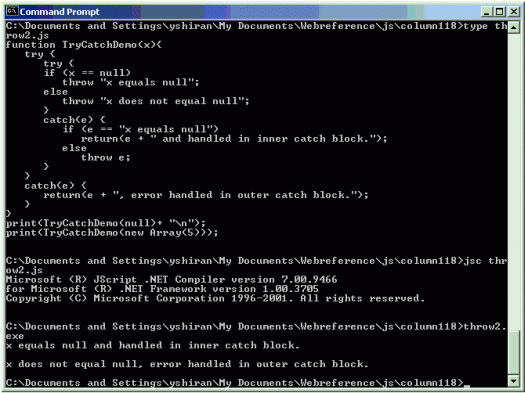JScript .NET, Part XII: Exception Handling: Throwing String Exceptions II - Doc JavaScript
JScript .NET, Part XII: Exception Handling
Throwing String Exceptions II
Let's look at another example that illustrates the multiple nesting levels of the try...catch...finally statements. Here is the code:
function TryCatchDemo(x){ try { try { if (x == null) throw "x equals null"; else throw "x does not equal null"; } catch(e) { if (e == "x equals null") return(e + " and handled in inner catch block."); else throw e; } } catch(e) { return(e + ", error handled in outer catch block."); } } print(TryCatchDemo(null)+ "\n"); print(TryCatchDemo(new Array(5)));
Notice that the finally statements are omitted, as they are only optional. We define the function TryCatchDemo() to act differently if its argument is null or not. If the argument is null, the error is handled in the inner catch block. If the argument is not null, the exception is handled in the outer catch block. We call the function twice: once with the null value, and once with a real Array object:
print(TryCatchDemo(null)+ "\n"); print(TryCatchDemo(new Array(5)));
Save this code in a file, say throw2.js, compile it, and run it. Your Command Prompt window should look like this:

Next: How to throw object exceptions
Produced by Yehuda Shiran and Tomer Shiran
All Rights Reserved. Legal Notices.
Created: September 9, 2002
Revised: September 9, 2002
URL: https://www.webreference.com/js/column118/5.html


 Find a programming school near you
Find a programming school near you